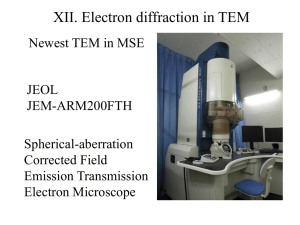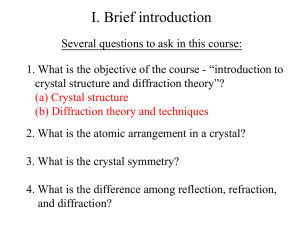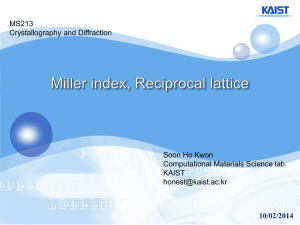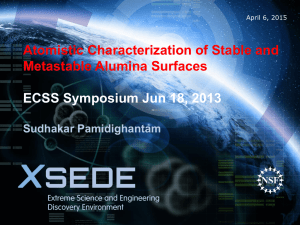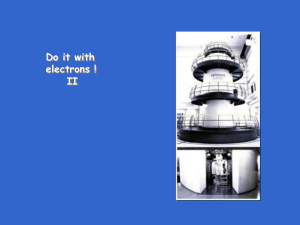Lecture 6
advertisement
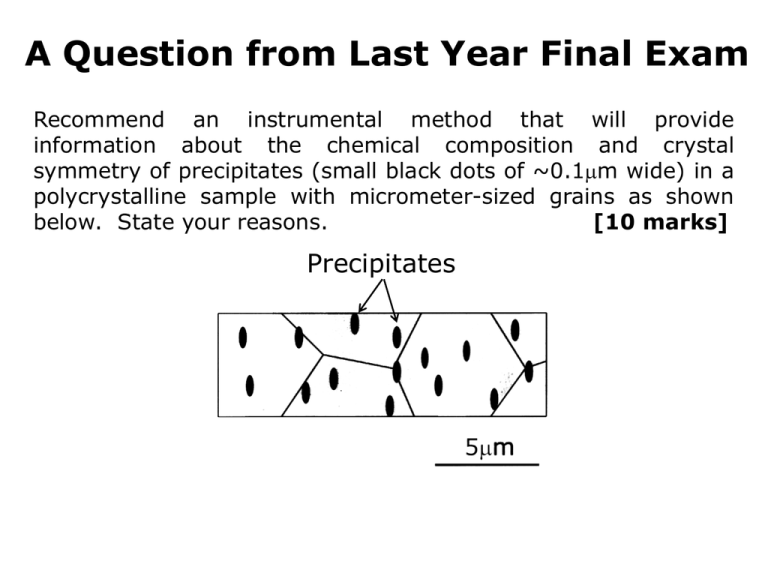
http://emalwww.engin.umich.edu/education_materials/microscopy.html
A Question from Last Year Final Exam
Recommend an instrumental method that will provide
information about the chemical composition and crystal
symmetry of precipitates (small black dots of ~0.1m wide) in a
polycrystalline sample with micrometer-sized grains as shown
below. State your reasons.
[10 marks]
Precipitates
http://www.youtube.com/watch?v=yqLlgIaz1L0
see atoms by TEM
Limits of OM, SEM, SPM and XRD
NN
G.B.
core
BT
EDS
shell
NN G.B.
BT
BT-BaTiO3
0.2m NN-NaNbO3
G.B.-Grain boundary
M.G.J.-multiple grain
junction
M.G.J.
NN/BT
•Lateral resolution: ~m
•Details of microstructure:
e.g., domain structure,
chemical inhomogeneity
phase distribution, grain
boundaries, interfaces,
precipitates, dislocations,
etc.
Chemical analysis at a nanometer scale
in a Transmission Electron Microscope
(TEM)
Why TEM?
The uniqueness of TEM is the ability to
obtain full morphological (grain size, grain
boundary and interface, secondary phase
and distribution, defects and their nature,
etc.), crystallographic, atomic structural
and microanalytical such as chemical
composition (at nm scale), bonding
(distance
and
angle),
electronic
structure, coordination number data from
the sample.
TEM is the most efficient and versatile
technique for the characterization of
materials.
http://www.youtube.com/watch?v=yqLlgIaz1L0
see atoms by TEM
Lecture-6
Transmission Electron Microscopy (TEM)
Scanning Transmission Electron Microscopy (STEM)
• What is a TEM?
• How it works - gun, lenses, specimen holder
• Resolution
• What can a TEM do?
• Imaging and diffraction
Imaging-diffraction and phase contrast
Diffraction-Selected area electron diffraction (SAED)
and Convergent beam electron diffraction (CBED)
• Chemical analysis
EDS, Electron Energy Loss Spectroscopy (EELS)
Energy Filtered Imaging
http://emalwww.engin.umich.edu/education_materials/microscopy.html
http://www.youtube.com/watch?v=6fX1m2rImiM
to~2:40 History & applications
Lecture-6
What is TEM?
Transmission Electron Microscopy (TEM)
Scanning Transmission Electron Microscopy (STEM)
TEM is an microscopy technique that functions
•similar
What
is
a
TEM?
to a light microscope, which uses a beam of
• How it works - gun, lenses, specimen stage
exited
electrons as a light source to provide
• Resolution
mophorlogical,
compositional and crystallographic
information of an ultra thin specimen.
The image is formed by the interaction of the
electrons transmitted through the specimen, which
is then magnified and focused on a fluorescence
screen containing a layer of photographic film.
http://www.youtube.com/watch?v=fxEVsnZT8L8
~2:20-2:40 fluorescence screen
http://www.youtube.com/watch?v=C3uU8c376Aw&list=PLIRAzwu_npNcnPGi2sOk2aaNaS3vzU-N1
Milestones of Science: Ernst Ruska and the Electron Microscope at~5:00-7:15 and ~9:03-9:23
Comparison of OM and TEM
Principal features of an optical microscope and a
transmission electron microscope, drawn to emphasize the
similarities of overall design.
http://www.youtube.com/watch?v=fToTFjwUc5M
Structure and Function of TEM
CM200 (200kV)
Column
Condenser
Lens
Objective Lens
SAD Aperture
Electron Gun
EDS Detector
Specimen Holder
Binocular
TV Monitor
Camera
Chamber
Magnifying
Lenses
Viewing Chamber
Cost: $4,000,000
http://www.youtube.com/watch?v=6fX1m2rImiM at~2:40-4:40
http://www.youtube.com/watch?v=2wEmsDh_l_A at~0:30
Vacuum
The electron microscope is built like a series of
vessels connected by pipes and valves separate
all the vessels from each other.
The vacuum around the specimen is around 10-7
Torr.
The vacuum in the gun depends on the type of
gun, either around 10-7 Torr (the tungsten or
LaB6 gun) or 10-9 Torr (for the Field Emission
Gun).
The pressure in the projection chamber is usually
only 10-5 Torr (and often worse). This pressure is
not very good because the projection chamber
holds the negatives used to record images. Even
though we dry the negatives before putting them
in the microscope, they still will give off so many
gases that the vacuum in the projection chamber
never gets very good.
How it works? The Lenses in TEM
http://www.youtube.com/watch?v=j2A6KeWrqeM&feature=related
at~0:20-0:44
Condenser lenses(two)-control how
strongly beam is focused (condensed)
onto specimen. At low Mag. spread
beam to illuminate a large area, at high
Mag. strongly condense beam.
Objective lens-focus image (image
formation) and contribute most to
the magnification and resolution of
the image. Magnetic material
Running water
B
Cu coils
Four lenses form magnification
system-determine the magnification
of the microscope. Whenever the
magnification is changed, the currents
through these lenses change.
at~5:50-7:00
http://www.youtube.com/watch?v=C3uU8c376Aw&list=PLIRAzwu_npNcnPGi2sOk2aaNaS3vzU-N1
How it works? Image Formation in TEM
A disc of metal
Control
brightness,
convergence
under in
over
focus focus focus
Control contrast
Schematic of the Optics of a TEM
http://www.youtube.com/watch?v=6fX1m2rImiM
at~3:00-4:45
Why Electrons?
Resolution
In expression for the resolution
(Rayleigh’s Criterion)
r = 0.61/nsin
Green Light
~400nm
n~1.7 oil immersion
r~150nm (0.15m)
Electrons
-wavelength, =[1.5/(V+10-6V2)]1/2 nm
V-accelerating voltage, n-refractive index
-aperture of objective lens, very small in TEM
sin and so r=0.61/ ~0.1 radians
0.1 radians ~ 5.5o
200kV Electrons
-beam convergence
~0.0025nm
n~1 (vacuum)
r~0.02nm (0.2Å) 1/10th size of an atom!
UNREALISTIC! WHY?
Resolution Limited by Lens Aberrations
Chromatic aberration is
caused by the variation of
the electron energy and
thus electrons are not
monochromatic.
point is imaged
as a disk.
Spherical
aberration
is
caused by the lens field
acting inhomogeneously on
the off-axis rays.
rmin0.91(Cs3)1/4
point is imaged
as a disk.
Practical resolution of microscope.
Cs–coefficient of spherical
aberration of lens (~mm)
Beam and Specimen Interaction
(EDS)
BF
DF
HREM
Imaging
(EELS)
SAED & CBED
diffraction
Scanning Transmission Electron Microscopy
(STEM)
JEOL 2000FX
Analytical Electron Microscope
Scanning
beam
specimen
HAADF
Detector
ADF
BF
ADF
DF
BF
STEM detector
or EELS
In STEM, the
electron beam is
rastered (scan
coil) across the
surface of a
sample in a similar
manner to SEM,
however, the
sample is a thin
TEM section and
the diffraction
contrast image is
collected on a
solid-state (ADF)
detector.
HAADF-high angle
annular dark-field
http://www.youtube.com/watch?v=WJUL22UoCLI Scanning transmission electron holography microscope
http://en.wikipedia.org/wiki/Scanning_transmission_electron_microscopy
Specimen Holder
Rotation, tilting, heating, cooling and straining
beam
holder
a split polepiece
objective lens
Twin specimen holder
Double tilt heating
Heating and straining
http://www.youtube.com/watch?v=j2A6KeWrqeM&feature=related
at~0:56-1:42
Specimen Holder with Electrical
Feedthroughs
http://www.youtube.com/watch?v=fxEVsnZT8L8
at~3:00-3:34
Specimen Preparation-Destructive
Dispersing crystals or powders on a carbon film on a grid
3mm
Making a semiconductor specimen with a Focused Ion Beam (FIB)
1
1.
2.
3.
4.
5.
2
3
4
5
a failure is located and a strip of Pt is placed as a protective cover.
On one side of the strip a trench is milled out with the FIM.
The same is done on the other side of the strip (visible structure).
The strip is milled on both sides and then the sides connecting the
strip to the wafer are cut through.
The strip is tilted, cut at the bottom and deposited on a TEM grid.
http://www.youtube.com/watch?v=F0ZNUykXovk
Preparing specimen
Specimen Preparation-2
Ion-milling a ceramic
Ar (4-6keV, 1mm A)
3mm
Ultrasonic cut
Dimple center part ion-mill until a hole
grind
of disk to ~5-10m appears in disk
Jet-polishing metal
-
+
a thin stream of acid
Drill a 3mm
cylinder
A disk is mounted in a
Cut into disks
jet-polishing machine
and grind
and is electropolished
until a small hole is
made.
Ultramicrotomy-using a (diamond) knife blade
Mainly for sectioning biological materials.
To avoid ion-milling damage ultramicrotome can also be used
to prepare ceramic TEM specimens.
http://www.ims.uconn.edu/~micro/Dimple%20Grinding2.pdf
TEM specimen preparation
What can a TEM do?
Imaging
BF and DF imaging
HREM
BF - Bright Field
DF - Dark Field
Objective
Aperture
(OA)
BF & DF Imaging – Diffraction Contrast
OA
OA
DDF
CDF
Beam
tilt
crystal
D
T-transmitted
D-diffracted
C-film
amorphous
D
Objective
aperture
T
T
BF image
C-film
Hole in OA
Objective
aperture
DF image
C-film
crystal
crystal
Diffraction + mass-thickness Contrast
http://micro.magnet.fsu.edu/primer/virtual/virtualzoo/index.html
Diffraction, Thickness and Mass Contrast
BF images
Weak diffraction
Strong
diffraction
2
thinner
thicker
G.B.
8
7
1
thickness
fringes
3
thickness
Disk specimen
6
5
4
8 grains are in different orientations
or different diffraction conditions
Low
mass
.
.
.
High
.
.
.
.
.
.
.
.
.
.
.
. . ..
. .... mass
T
T
S
S
Bright Dark
S
BF and DF Imaging
Incident beam
allowed to pass objective aperture to
form images.
BF
specimen
diffracted
BF imaging-only transmitted beam is
beam
mass-thickness
contrast
DF imaging
only diffracted
beams are
allowed to pass
transmitted beam
the aperture to
objective aperture form images.
hole in objective
aperture(10-100m)
Particles in Al-Cu
Alloy.
thin platelets ll e
Vertical, dark
Particles e.
DF
DF
Phase Contrast Imaging
High Resolution Electron
Microscopy (HREM)
D
Si
T
BN
Objective
aperture
Electron diffraction pattern recorded
From both BN film on Si substrate.
Use a large objective
aperture.
Phases and intensities
of diffracted and
transmitted beams
are combined to form
a phase contrast
image.
http://www.matter.org.uk/diffraction/electron/electron_diffraction.htm
Electron Diffraction
Geometry for
e-diffraction
edhkl
Specimen
foil
e-beam
Zone axis
of crystal
Bragg’s Law: =2dhklsinhkl
2
L
sample
r
T
=[1.5/(V+10-6V2)]1/2 nm
=0.037Å (at 100kV)
=0.26o if d=4Å
e-beam is almost = 2d
parallel to {hkl} r/L=sin2
as 0
r/L = 2
D
Reciprocal
lattice
X-ray
crystal
polycrystal
r/L = /d or
r = Lx
1
d
L -camera length
r -distance between T and D spots
hkl
1/d -reciprocal of interplanar distance(Å-1)
[hkl] SAED pattern SAED –selected area electron diffraction
http://www.youtube.com/watch?v=fxEVsnZT8L8
at~3:00-3:34
Reciprocal Lattice
A reciprocal lattice is another way of view a crystal
lattice and is used to understand diffraction patterns.
A dimension of 1/d (Å-1) is used in reciprocal lattices.
g – reciprocal lattice vector
http://www.youtube.com/watch?v=iC15RHX4gpQ
2-D Reciprocal Lattices
For every real lattice there is an equivalent reciprocal lattice.
Real space:
Unit cell vectors: a,b
d-spacing direction
a
d10
[10]
b
d01
[01]
[01]
[10]
(10)
Reciprocal space:
Unit cell vectors: a*,b*
magnitude direction
b
a* 1/d10
a
b* 1/d01
b*
a*
(01)
01
02
10
11
A reciprocal lattice can
be built using reciprocal
12
vectors. Both the real
20
and reciprocal construc21
22
tions show the same
lattice, using different
Note: each point in the reciprocal
but equivalent
lattice represents a set of planes.
descriptions.
http://www.matter.org.uk/diffraction/geometry/2d_reciprocal_lattices.htm
3-D Reciprocal Lattice
Real space:
Unit cell vectors: a,b,c
magnitude direction
a
d100
[100]
b
d010
[010]
c
d001
[001]
Orthorhombic
Reciprocal space:
Unit cell vectors: a*,b*
magnitude direction
a* 1/d100 b and c
b* 1/d010 a and c
a and b
c* 1/d001
Note: as volume of unit cell in real space increases the
volume of unit cell in reciprocal space decreases, and
vice versa. a*,b* and c* are parallel to corresponding a,b and
c, and this is only true for the unit cells of cubic, tetragonal
and orthorhmbic crystal systems.
http://www.matter.org.uk/diffraction/geometry/3d_reciprocal_lattices.htm
http://www.matter.org.uk/diffraction/geometry/reciprocal_lattice_exercises.htm
Lattice Vectors
Real space lattice vector
corresponds to directions
in crystal and it can be
defined as:
r=ua+vb+wc
a,b and c are unit cell vectors,
u,v and w are components of
the direction index [uvw].
A reciprocal lattice vector
can be written as:
g*=ha*+kb*+lc*
a*,b* and c* are reciprocal
unit vectors, and h,k and l
are the Miller indices of the
plane (hkl).
Effect of Spacing of planes in Real Space on
Length of Reciprocal Vector, g
-
[111]
-
(111)
d111
In a crystal of any structure, ghkl is normal to the (hkl)
plane and has a length inversely proportional to the
interplanar spacing of the planes.
http://www.matter.org.uk/diffraction/geometry/reciprocal_vector_g.htm
Why are there so many spots?
Ewald Sphere and Diffraction Pattern
SAED pattern
Reciprocal Lattice
k – wave vector
lkl = 1/
– wavelength of electron
XRD pattern
Reciprocal Lattice
The Ewald Sphere and Diffraction Pattern
Ewald Sphere Construction
1/
A set of real
lattice planes
T
D
k – wave vector
lkl = 1/
– wavelength of electron
Bragg’s Law
http://www.matter.org.uk/diffraction/geometry/ewald_sphere_diffraction_patterns.htm
XRD
R
Why there are so
many diffraction
spots in ED?
R=1/
SAED
R
R=1/
parallel beam
Virtual
aperture
specimen
Objective
lens
Diffraction
pattern
SAD
aperture
SAED
Selected Area Electron Diffraction
A TEM technique to
reduce both the area
and intensity of the
beam contributing to a
diffraction pattern by
the insertion of an
aperture into the
image plane of the
objective lens. This
Back focal produces a virtual
plane
diaphragm in the plane
of the specimen.
Focusing SAED Pattern at Fixed Screen
by changing magnetic lens strength
specimen
lens
Diffracted beam
Transmitted beam
SAED gives 2-D information
Spot pattern
http://www.matter.org.uk/diffraction/electron/electron_diffraction.htm
screen
SAED Patterns of Single Crystal,
Polycrystalline and Amorphous Samples
a
b
c
020
110
200
r 1 r2
a. Single crystal Fe (BCC) thin film-[001]
b. Polycrystalline thin film of Pd2Si
c. Amorphous thin film of Pd2Si. The diffuse
halo is indicative of scattering from an
amorphous material.
Diffraction Spot Intensity
Spot intensity: Ihkl lFhkll2
Fhkl - Structure Factor
N
Fhkl = fj exp[2i(hu+kv+lw)]
j=1
fj –
atomic scattering factor
fj Z, sin/
h,k,l are Miller indices and u,v,w fractional coordinates
_
[013]
131 (311)?
200
_
SAED
SAED Patterns
dhkl = L/rhkl
the table
SAED
50nm
Next Lecture
TEM
Convergent beam electron diffraction (CBED)
Chemical analysis
EDS, Electron Energy Loss Spectroscopy (EELS)
Energy Filtered Imaging
Secondary Ion Mass Spectroscopy (SIMS)

